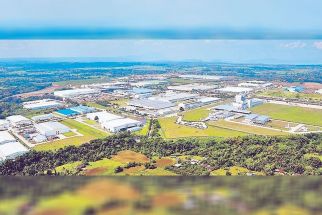Philippines GDP forecasts recast downward
We’re not out of the woods yet, says BSP chief
MANILA, Philippines — The worst economic performance on record logged in the second quarter has forced monetary authorities and economists to further downgrade their year-end forecasts for the Philippines.
While they believe the worst is over for the Philippine economy as gross domestic product (GDP) contracted by 16.5 percent in the second quarter, at the height of the strict lockdown that paralyzed most parts of the country, an improvement in the third and fourth quarters could be in the offing, paving the way for a strong recovery next year.
“I believe the worst is behind us. But we’re not out of the woods yet,” Bangko Sentral ng Pilipinas (BSP) Governor Benjamin Diokno told reporters, adding that “the second quarter GDP numbers were largely due to the comprehensive lockdown during the period.”
In a press briefing yesterday, Finance Secretary Carlos Dominguez said the country’s economic performance in the first half roughly falls within the middle of its credit rating peers.
“The first half of the year has been tough. The Philippines, like other countries, took decisive and life-saving measures to contain COVID-19, at the expense of economic growth,” he said.
The finance chief said the government did not neglect its responsibility of providing relief to vulnerable sectors and carrying out measures to keep the economy afloat, which resulted in higher expenditures in the first half of the year.
Without increased public sector spending, Dominguez said first semester GDP would have shrunk further by 2.5 percentage points more than it did, or a contraction of 11.5 percent instead of the actual nine percent.
“Although the first semester figures underscore the challenges ahead of us, with the public’s cooperation and if we work together to shore up consumer confidence, we will deliver better economic outcomes in the final half of this year,” he said.
In a statement released yesterday, the inter-agency Development Budget Coordination Committee (DBCC) said it now estimates a 5.5 percent GDP contraction this year, worse than the previous estimate of two to 3.4 percent, noting that the economic slump caused by the pandemic was worse than expected.
DBCC said the revision was made “in view of updated indicators on the impact of the COVID-19 pandemic on tourism, trade and remittances throughout the year.”
Nevertheless, DBCC expressed confidence the country is “on track” toward economic recovery next year, with GDP growth expected to reach 6.5 percent to 7.5 percent in 2021 and 2022.
Meanwhile, regional think tank ASEAN+3 Macroeconomic Research Office (AMRO) has also adjusted its forecast for the country’s economic performance and now expects a 6.6 percent contraction this year given the latest GDP result and the impact of the COVID-19 crisis.
The country officially plunged into a recession as GDP declined for the second straight quarter, according to data from the Philippine Statistics Authority.
AMRO’s chief economist Hoe Ee Khor said in a virtual media briefing that while the think tank expected the Philippine economy to take a beating in the second quarter, the actual GDP result was worse than expected.
“We actually had a forecast of a decline of 13 percent,” he said.
In its ASEAN+3 Regional Economic Outlook (AREO) 2020 released yesterday, AMRO estimated a 3.8 percent contraction for the Philippine economy this year and a 7.1 percent growth for next year.
Khor said while most countries in the ASEAN+3 region have managed to plank the curve and reduce infection rates, the Philippines and Indonesia continue to see rising cases of COVID-19.
“The Philippines has been one of the countries most badly hit by this pandemic. The structure of the economy is very different. It is a service economy dependent on the BPO (business process outsourcing), tourism and remittances. A lot of Filipino nationals working abroad lost their job and they have been repatriated,” he said.
The BSP chief also said policy makers now know more about the appropriate response to the pandemic as they learn more about the virus.
“We know from our experience and the experiences of other jurisdictions of what works and what doesn’t work. A big part of the success in overcoming this crisis may be attributed to leadership, clear messaging and human behavior,” Diokno said.
Diokno said that each individual has a role to play in winning the war against the virus.
“The virus won’t go away soon, so we have to learn to live with it. The days of comprehensive, nationwide lockdown are over; they exact a heavy damage to the economy, jobs, livelihoods and incomes. Henceforth, the focus of national leaders should be on more localized village level or building level containment. Isolation facilities should be built in all major cities and large municipalities, in support of the government’s test, trace and treat strategy,” Diokno said.
Noelan Arbis, economist at HSBC, said the 16.5 percent GDP contraction in the second quarter was a shocking outcome as it not only exceeded market expectations, but marked one of the biggest economic contractions reported globally as a result of the health crisis.
“The GDP report points to the need for an all hands on deck approach to boosting the economy. Indeed, today’s figure poses significant downside risk to our GDP forecast of -3.9 percent this year, but more importantly, it is very likely to undershoot the government’s just revised forecast of a 5.5 percent contraction,” Arbis said.
The British banking giant expects the Monetary Board to further slash interest rates by another 25 basis points in the fourth quarter on top of the cumulative 175 basis points cuts this year as well as further lowering of the reserve requirement ratio.
Rizal Commercial Banking Corp. chief economist Michael Ricafort said the bigger-than-expected contraction in the second quarter and the two-week stricter lockdown in Metro Manila and nearby provinces could lead to further monetary easing measures to provide needed support for the economy.
“Thus, prospects of economic recovery could be reduced at the moment, until the modified enhanced community quarantine is relaxed and the local economy together with the various manufacturing activities further re-open again in the coming weeks and months and increase their operating capacity amid social-distancing and other stringent health protocols to prevent the further spread of COVID-19,” Ricafort said.
ANZ Research economist Kanika Bhatnagar said the recent resurgence of infections and the reimposition of mobility restrictions could delay the country’s recovery.
“The growth outlook is challenging…. the pace of improvement in high frequency indicators cannot assure a recovery in the second half of 2020. We will be revisiting our GDP forecasts,” Bhatnagar said. MG Padin , Louella Desiderio
Related video:
- Latest
- Trending





























